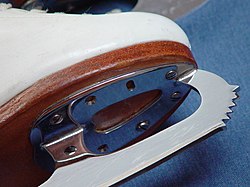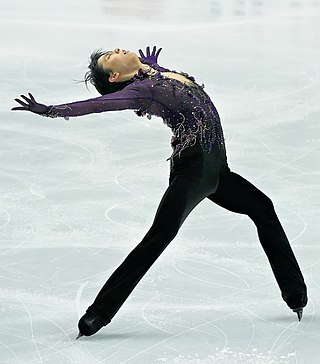
Figure skating is a sport in which individuals, pairs, or groups perform on figure skates on ice. It was the first winter sport to be included in the Olympic Games, with its introduction occurring at the 1908 Olympics in London. The Olympic disciplines are men's singles, women's singles, pair skating, and ice dance; the four individual disciplines are also combined into a team event, which was first included in the Winter Olympics in 2014. The non-Olympic disciplines include synchronized skating, Theater on Ice, and four skating. From intermediate through senior-level competition, skaters generally perform two programs, which, depending on the discipline, may include spins, jumps, moves in the field, lifts, throw jumps, death spirals, and other elements or moves.

Snowboards are boards where the user places both feet, usually secured, to the same board. The board itself is wider than most skis, with the ability to glide on snow. Snowboards widths are between 6 and 12 inches or 15 to 30 centimeters. Snowboards are differentiated from monoskis by the stance of the user. In monoskiing, the user stands with feet inline with direction of travel, whereas in snowboarding, users stand with feet transverse to the longitude of the board. Users of such equipment may be referred to as snowboarders. Commercial snowboards generally require extra equipment such as bindings and special boots which help secure both feet of a snowboarder, who generally ride in an upright position. These types of boards are commonly used by people at ski hills, mountains, backcountry, or resorts for leisure, entertainment, and competitive purposes in the activity called snowboarding.
Figure skating jumps are an element of three competitive figure skating disciplines: men's singles, women's singles, and pair skating – but not ice dancing. Jumping in figure skating is "relatively recent". They were originally individual compulsory figures, and sometimes special figures; many jumps were named after the skaters who invented them or from the figures from which they were developed. It was not until the early part of the 20th century, well after the establishment of organized skating competitions, when jumps with the potential of being completed with multiple revolutions were invented and when jumps were formally categorized. In the 1920s Austrian skaters began to perform the first double jumps in practice. Skaters experimented with jumps, and by the end of the period, the modern repertoire of jumps had been developed. Jumps did not have a major role in free skating programs during international competitions until the 1930s. During the post-war period and into the 1950s and early 1960s, triple jumps became more common for both male and female skaters, and a full repertoire of two-revolution jumps had been fully developed. In the 1980s men were expected to complete four or five difficult triple jumps, and women had to perform the easier triples. By the 1990s, after compulsory figures were removed from competitions, multi-revolution jumps became more important in figure skating.

Spins are an element in figure skating in which the skater rotates, centered on a single point on the ice, while holding one or more body positions. They are performed by all disciplines of the sport, single skating, pair skating, and ice dance, and are a required element in most figure skating competitions. As The New York Times says, "While jumps look like sport, spins look more like art. While jumps provide the suspense, spins provide the scenery, but there is so much more to the scenery than most viewers have time or means to grasp". According to world champion and figure skating commentator Scott Hamilton, spins are often used "as breathing points or transitions to bigger things".

Ice skates are metal blades attached underfoot and used to propel the bearer across a sheet of ice while ice skating.
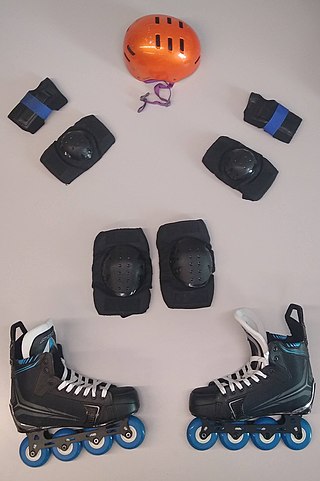
Inline skates are a type of roller skate used for inline skating. Unlike typical roller skates, which have two front and two rear wheels, inline skates typically have two to five wheels arranged in a single line. Some, especially those for recreation, have a rubber "stop" or "brake" block attached to the rear of one or occasionally both of the skates so that the skater can slow down or stop by leaning back on the foot with the brake skate.

Inline speed skating is the roller sport of racing on inline skates. The sport may also be called inline racing, or speed skating by participants. Although it primarily evolved from racing on traditional roller skates, the sport is similar enough to ice speed skating that many competitors are known to switch between inline and ice speed skating according to the season.

A blade is the portion of a tool, weapon, or machine with an edge that is designed to puncture, chop, slice or scrape surfaces or materials. Blades are typically made from materials that are harder than those they are to be used on. Historically, humans have made blades from flaking stones such as flint or obsidian, and from various metal such as copper, bronze, and iron. Modern blades are often made of steel or ceramic. Blades are one of humanity's oldest tools, and continue to be used for combat, food preparation, and other purposes.

Compulsory figures or school figures were formerly a segment of figure skating, and gave the sport its name. They are the "circular patterns which skaters trace on the ice to demonstrate skill in placing clean turns evenly on round circles". For approximately the first 50 years of figure skating as a sport, until 1947, compulsory figures made up 60 percent of the total score at most competitions around the world. These figures continued to dominate the sport, although they steadily declined in importance, until the International Skating Union (ISU) voted to discontinue them as a part of competitions in 1990. Learning and training in compulsory figures instilled discipline and control; some in the figure skating community considered them necessary to teach skaters basic skills. Skaters would train for hours to learn and execute them well, and competing and judging figures would often take up to eight hours during competitions.
The toe loop jump is the simplest jump in the sport of figure skating. It was invented in the 1920s by American professional figure skater Bruce Mapes. The toe loop is accomplished with a forward approach on the inside edge of the blade; the skater then switches to a backward-facing position before their takeoff, which is accomplished from the skater's right back outside edge and left toepick. The jump is exited from the back outside edge of the same foot. It is often added to more difficult jumps during combinations and is the most common second jump performed in combinations. It is also the most commonly attempted jump.

Motorcycle boots are associated with motorcycle riders and range from above ankle to below knee boots. They have an outside of a typical boot but a low heel to control the motorcycle. To improve motorcycle safety, motorcycle boots are generally made from a thick, heavy leather and may include energy absorbing and load spreading padding, metal, plastic and/or composite materials to protect the motorcycle rider's feet, ankles and legs in an accident. For use in wet weather, some boots have a waterproof membrane lining such as Gore-Tex or SympaTex.

A kitchen knife is any knife that is intended to be used in food preparation. While much of this work can be accomplished with a few general-purpose knives – notably a large chef's knife, a tough cleaver, a small paring knife and some sort of serrated blade – there are also many specialized knives that are designed for specific tasks. Kitchen knives can be made from several different materials.
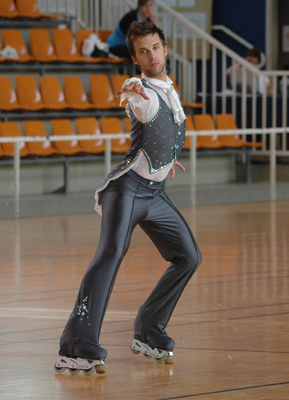
Artistic roller skating is a competitive sport similar to figure skating but where competitors wear roller skates instead of ice skates. Within artistic roller skating, there are several disciplines:
The loop jump is an edge jump in the sport of figure skating. The skater executes it by taking off from the back outside edge of the skating foot, turning one rotation in the air, and landing on the back outside edge of the same foot. It is often performed as the second jump in a combination.

Victor Kraatz, is a Canadian former ice dancer. In 2003, he and his partner, Shae-Lynn Bourne, became the first North American ice dancers to win a World Championship.
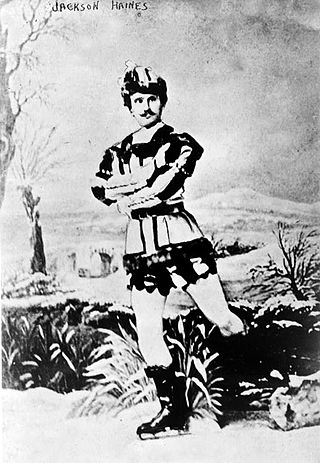
Jackson Haines (1838–1875) was an American figure skater and roller skater who is regarded as the father of modern figure skating.
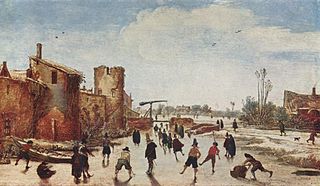
The history of figure skating stretches back to prehistoric times. Primitive ice skates appear in the archaeological record from about 3000 BC. Edges were added by the Dutch in the 13th and 14th century. International figure skating competitions began appearing in the late 19th century; in 1891, the European Championships were inaugurated in Hamburg, Germany, and in 1896, the first World Championship were held in Saint Petersburg, Russian Empire. At the 1908 Summer Olympics in London, England, figure skating became the first winter sport to be included in the Olympics.
The following is a glossary of figure skating terms, sorted alphabetically.
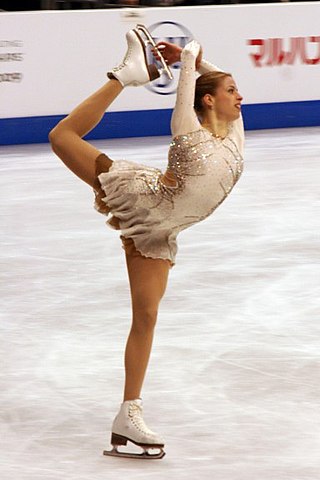
Single skating is a discipline of figure skating in which male and female skaters compete individually. Men's singles and women's singles are governed by the International Skating Union (ISU). Figure skating is the oldest winter sport contested at the Olympics, with men's and women's single skating appearing as two of the four figure skating events at the London Games in 1908.
The upright spin is one of the three basic figure skating spin positions. The International Skating Union (ISU), the governing body of figure skating, defines an upright spin as a spin with "any position with the skating leg extended or slightly bent which is not a camel position". It was invented by British figure skater Cecilia Colledge. Variations of the upright spin include the layback spin, the Biellmann spin, the full layback, the split, the back upright spin, the forward upright spin, the scratchspin, and the sideways leaning spin.


